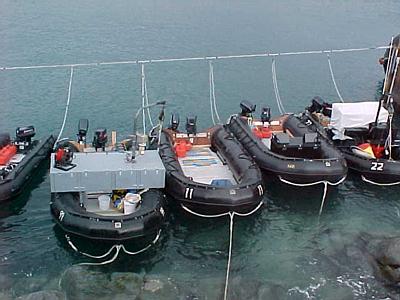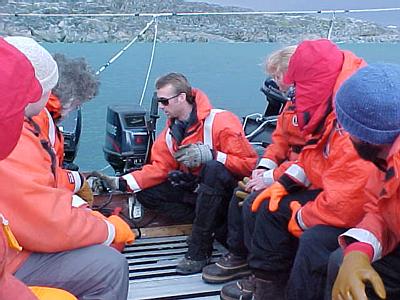10 March, 2000
Boating Two Course
Question 20: How many species of penguins are there?
We spent most of today getting things unpacked for the laboratory spaces that
have been assigned to us and getting the tanks ready for organisms. The
weather calmed down enough at noon for our group to go out and finish our
schooling with the Boating Coordinator (BC).
The Boating Two course focuses on operating the boats, a fleet of Zodiacs
with 45-55hp (horse power) engines. All members of our group got dressed in
wet weather gear with rain pants, float coats, and heavy boots and trooped
down to the large Mark V Zodiac that is assigned to us. We went through how
to moor the boats at the station and on islands, how to operate the motors,
motor trouble-shooting, radio protocol for divers in the water/weather
checks/emergencies, tricks for better operation with high winds or surface
ice, and wildlife to watch out for.
Then everyone took turns starting up the motor and taking the group out for a
spin in Hero Inlet and Arthur Harbor. The wind beyond Gammage Point (where
the station is situated) was whipping up choppy whitecaps so, although Boating
Two usually includes it, we did not do a tour of the open boating area. Boats
can operate only within a two-mile radius of the station. This area is
determined primarily by where a search and rescue (SAR) team could reach
boaters in distress in a reasonable amount of time. With water temperature
here ranging a degree above or below freezing, a person in the water has
approximately 12 minutes until serious hypothermia sets in. The boating range
is not parcticularly limiting for the science groups operating in the area as
it includes all the islands except the Outcast Islands (at the extreme lower
left of the map). The weather currently is keeping everyone within sight of
the station.
Other things we have to be aware of while boating are staying at least 200
meters away from glaciers and icebergs because of the risk of calving (chunks
of ice falling off the glacier) or turtling (iceberg turning over). If we
sight the local pod of killer whales, we must either pull up on an island or
return to the station. We must also watch for leopard seals, which are large
and curious. The BC warned us that if a leopard seal is in the water with
penguins, the penguins will hop up on anything including a boat to get out of
the water!
Boat use priority here goes first for SAR, then scientific use, then support
work and finally recreation. During the highest use time during the summer
season, the Boating Coordinator was keeping 18 Zodiacs in the water. Since
then they have been breaking them down and storing them for the winter and
will continue to do so until they reach the winter fleet of 3-4 boats.
Currently there are 8 in use. Our group has a dedicated Zodiac as does SAR.
The third winter boat will be for general-use work or recreation.
Normally, the station staff (not scientists--we work whenever we are awake)
has Sunday off. However, during the winter season, the first weekend of every
month is a two-day weekend. We celebrated the first one tonight (last weekend
was too busy to take time off), as well as a birthday. They brought out
tablecloths, napkins and candlelight for the King Crab or Prime Rib. The
birthday cake was a Baked Alaska. The food both here and on the boat is very
good normally, but that is due to the skill of the cooks rather than the basic
content. Tonight it was fancy food, though still served cafeteria style.
Answer 19: It is fall. The short change-over seasons (fall and spring) here
have the most volatile weather. Storms blow up quickly and frequently. The
temperature is hovering around freezing, giving us some rain, some sleet, some
snow....but not lots of anything. The wind has been blowing from 10 to 60
knots, icebergs are actively melting and the glacier is actively calving.

Part of the Palmer Station fleet of Zodiacs.

Boating Coordinator Ross with our scientific group in the Zodiac.

Palmer Station vicinity.

Upper end of Hero Inlet.

Contact the TEA in the field at
.
If you cannot connect through your browser, copy the
TEA's e-mail address in the "To:" line of
your favorite e-mail package.
|
